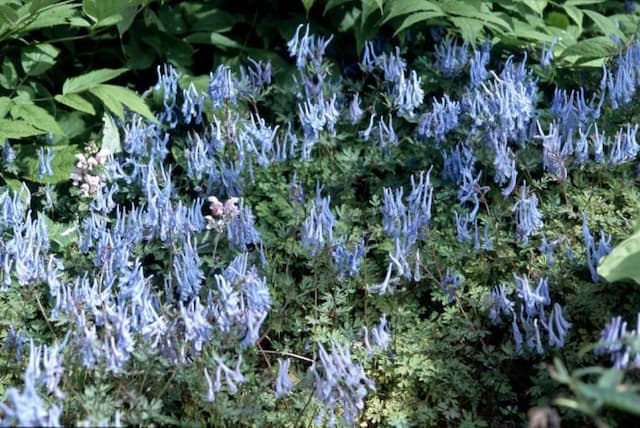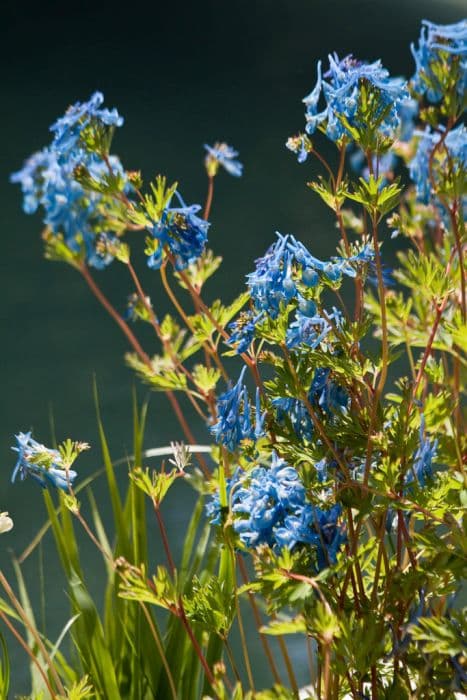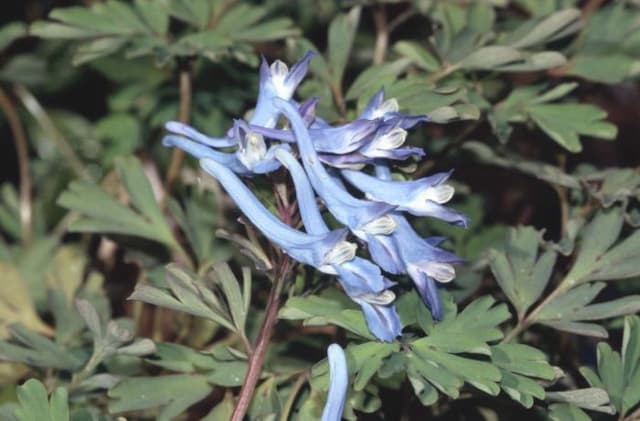Corydalis 'Canary Feathers' (PBR)

ABOUT
Corydalis 'Canary Feathers' is a striking plant with a lush appearance that captivates the eye. It possesses a delicate and feathery foliage that is richly green, creating an airy and fern-like backdrop. Upon this foliage sit the plant's distinctive blooms, which are tubular flowers that exude an enchanting sunny yellow hue, evocative of canary feathers—hence the plant's name. The flowers are gracefully arranged in elongated clusters, which cascade above the foliage, adding to its ornamental charm. The overall visual effect of Corydalis 'Canary Feathers' is one of cheerful elegance, making it a delightful addition to any garden setting where its beauty can be enjoyed.
About this plant
 Names
NamesSynonyms
Canary Feathers Corydalis, Yellow Corydalis.
Common names
Corydalis 'Canary Feathers' (PBR).
 Toxicity
ToxicityTo humans
The Corydalis 'Canary Feathers' plant, commonly referred to as Corydalis, is not widely known for its toxicity to humans. There is limited information on its potential harmful effects if ingested. However, like many ornamental plants, it is not intended for consumption. If suspected of being ingested, it is advisable to consult a healthcare professional and monitor for any signs of discomfort or unusual symptoms, as they can vary individually.
To pets
The Corydalis plant, when ingested by pets, may lead to mild gastrointestinal upset, although it is not considered highly toxic. Signs of poisoning could potentially include symptoms such as nausea, vomiting, or diarrhea. It is always prudent to keep an eye on your pet and consult a veterinarian if you suspect they have consumed any part of the plant and are displaying adverse symptoms.
 Characteristics
CharacteristicsLife cycle
Perennials
Foliage type
Deciduous
Color of leaves
Green
Flower color
Yellow
Height
1 feet 2 inches (35 cm)
Spread
1 feet (30 cm)
Plant type
Herb
Hardiness zones
5
Native area
China
Benefits
 General Benefits
General Benefits- Attracts Pollinators - Corydalis 'Canary Feathers' is known for attracting bees and butterflies, which are vital for the pollination of many other plants.
- Aesthetic Appeal - With its bright yellow flowers and feathery foliage, it adds color and texture to garden spaces.
- Shade Tolerant - It can thrive in partially shaded areas where other plants might struggle, making it a versatile addition to various garden designs.
- Low Maintenance - Once established, it requires minimal care, making it ideal for busy gardeners or those who prefer low-maintenance landscapes.
- Long Blooming - The plant has a long flowering period from late spring to early summer, providing a lengthy display of vibrant color.
- Deer Resistant - It is not a preferred food source for deer, making it a good choice for gardens in areas with high deer populations.
- Compact Growth - Its compact habit makes it suitable for small gardens, borders, and containers without overpowering other plantings.
 Medical Properties
Medical Properties- This plant is not used for medical purposes.
 Air-purifying Qualities
Air-purifying QualitiesThis plant is not specifically known for air purifying qualities.
 Other Uses
Other Uses- Corydalis 'Canary Feathers' can be used in cut flower arrangements for their uniquely shaped blooms and delicate foliage, providing a touch of elegance and softness to bouquets.
- This plant can serve as a natural dye source; the yellow flowers may produce varying shades of yellow to green when used for dyeing fabrics or paper.
- As an educational tool in botanic gardens or schools, Corydalis 'Canary Feathers' helps illustrate the diversity of the plant kingdom, particularly in the study of the Fumariaceae family.
- The plant can be incorporated into sensory gardens, as its soft texture invites tactile interaction especially useful for therapeutic garden settings for visually impaired individuals.
- In artistic representations, the intricate flowers of Corydalis 'Canary Feathers' can be used as subjects for botanical illustration classes or as inspiration in floral design patterns.
- It can act as a living mulch, its dense foliage helps to retain soil moisture and suppress weed growth around garden beds or beneath shrub canopies.
- Corydalis 'Canary Feathers' can be used in container gardens where its cascading habit adds a vertical aspect and can be placed on balconies or patios for aesthetic improvement.
- Photographers can use Corydalis 'Canary Feathers' as an appealing background or focal point due to its bright flowers and attractive foliage, enhancing the composition of garden photography.
- This plant may be used in theme gardens such as fairy or miniature gardens due to its delicate and fern-like foliage, creating a sense of whimsy and enchantment.
- Corydalis 'Canary Feathers' may be grown as a companion plant to roses or other plants that benefit from the cooler, moist microclimate the Corydalis provides at their bases.
Interesting Facts
 Feng Shui
Feng ShuiCorydalis is not used in Feng Shui practice.
 Zodiac Sign Compitability
Zodiac Sign CompitabilityCorydalis is not used in astrology practice.
 Plant Symbolism
Plant Symbolism- Hope and Optimism: Due to its bright yellow flowers, Corydalis 'Canary Feathers', often simply known as Corydalis, is commonly associated with hope and optimism. The color yellow traditionally symbolizes brightness and positive energy, thus giving the plant this optimistic representation.
- Tranquility: Corydalis is also known to symbolize tranquility. Its delicate foliage and gentle appearance can evoke a sense of peacefulness and calm in a garden setting, which is why it might be associated with serenity.
- Overcoming Challenges: This plant has the ability to grow in difficult conditions, which leads it to represent the ability to overcome challenges. Gardeners admire Corydalis for its resilience and adaptability.
- Love and Affection: In the language of flowers, many plants with delicate and intricate flowers are seen as emblems of love and affection. Corydalis, with its intricate blooms, could be said to symbolize these emotions subtly.
 Water
WaterFor the Fumewort, ensure the soil is kept consistently moist but not waterlogged. Water the plant when the top inch of soil feels dry to the touch, which could be about once or twice a week, depending on climate conditions. Use approximately 16-24 ounces of water for smaller pots or up to 1-2 gallons for larger containers each time you water, ensuring even soil moisture. During hot summers, you might need to water more frequently, but always check the soil moisture first to avoid overwatering. In winter, reduce watering slightly as the plant's growth slows down.
 Light
LightFumewort thrives best in partial shade to full shade; direct sunlight can scorch the leaves. Ideally, plant it in a spot that receives dappled sunlight throughout the day or steady but gentle morning light with protection from the harsh afternoon sun. These light conditions mimic the plant's natural woodland habitat and provide the best environment for healthy growth.
 Temperature
TemperatureFumewort prefers cooler temperatures and can generally withstand minimum temperatures down to around 0 degrees Fahrenheit, though it's most comfortable in the range of 50-75 degrees Fahrenheit. They are not well-suited to extreme heat and should be protected from temperatures exceeding 80-85 degrees Fahrenheit, as prolonged heat can stress the plant.
 Pruning
PruningFumewort should be pruned to remove spent flowers and encourage further blooming, which can be done throughout the flowering period. Pruning is also important after flowering to tidy up the plant and prevent self-seeding if not desired. The best time for a major prune is in late fall or early spring to remove old foliage and make room for new growth.
 Cleaning
CleaningAs needed
 Soil
SoilCanary Feathers prefers a well-draining soil mix rich in organic matter with a pH range of around 6.5 to 7.5. A blend of loamy garden soil, peat moss, and perlite or sand in equal parts can create an ideal mix ensuring good drainage and aeration.
 Repotting
RepottingCanary Feathers should be repotted every 1-2 years, ideally in the spring. Replace the old soil with fresh mix to maintain nutrient quality and support healthy growth.
 Humidity & Misting
Humidity & MistingCanary Feathers thrives best in moderate to high humidity levels, ideally between 40-70%. Avoid placing the plant in excessively dry conditions to support its lush growth.
 Suitable locations
Suitable locationsIndoor
Place Canary Feathers in bright, indirect light with proper soil mix.
Outdoor
Grow Canary Feathers in dappled shade, protect from harsh sun.
Hardiness zone
5-9 USDA
 Life cycle
Life cycleThe life of Corydalis 'Canary Feathers' begins with seed germination, typically in the spring, when soil temperatures warm up. After germination, the plant's seedlings establish a rosette of leaves and a root system before entering a period of vegetative growth. During this stage, it develops its characteristic feathery foliage and prepares for flowering. Flowering generally occurs in late spring to early summer, showcasing the plant's bright yellow blooms that attract pollinators. Once pollinated, flowers develop into capsules containing tiny seeds, which are then dispersed by various means, completing the reproductive cycle. After setting seed, Corydalis 'Canary Feathers' can go dormant, particularly in hotter summer climates, but it typically remains semi-evergreen if conditions allow and may rebloom in cooler weather until the onset of winter.
 Propogation
PropogationPropogation time
Spring-Early Summer
Corydalis 'Canary Feathers', commonly known as Golden Corydalis, is often propagated through division. This is typically done in early spring or fall when the plant is not in active growth. To propagate by division, carefully lift the entire plant from the ground, ensuring to keep as much of the root system intact as possible. Gently pull apart the clumps into smaller divisions, each with several healthy roots and shoots. Replant these divisions at the same depth they were growing at before, spacing them about 12 inches (approximately 30 centimeters) apart, and water well to establish. This method allows for quicker establishment and flowering in the garden compared to starting from seeds.









